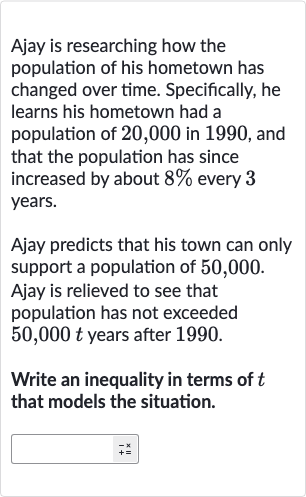AI tutor
Welcome to Bytelearn!
Let’s check out your problem:

Ajay is researching how the population of his hometown has changed over time. Specifically, he learns his hometown had a population of , in , and that the population has since increased by about every years.Ajay predicts that his town can only support a population of , .Ajay is relieved to see that population has not exceeded years after .Write an inequality in terms of that models the situation.
Full solution
Q. Ajay is researching how the population of his hometown has changed over time. Specifically, he learns his hometown had a population of , in , and that the population has since increased by about every years.Ajay predicts that his town can only support a population of , .Ajay is relieved to see that population has not exceeded years after .Write an inequality in terms of that models the situation.
- Identify Population and Growth Rate: Identify the initial population and the growth rate.The initial population in is , and the growth rate is every years.
- Convert to Exponential Growth Factor: Convert the growth rate to an exponential growth factor.The growth rate of every years can be expressed as a growth factor of . However, since the growth happens every years, we need to adjust the exponent to reflect this. The population after years can be modeled by the equation , where is the number of years after .
- Write Population Inequality: Write the inequality that represents the population not exceeding .We want to ensure that the population does not exceed . Therefore, the inequality will be .
- Substitute Values into Inequality: Substitute the values of and into the inequality.Substituting the values we have, we get .
- Simplify Final Inequality: Simplify the inequality to its final form.The inequality is already in its simplest form and correctly models the situation.
More problems from Write exponential functions: word problems
QuestionGet tutor help
QuestionGet tutor help
QuestionGet tutor help
QuestionGet tutor help
QuestionGet tutor help
QuestionGet tutor help
QuestionGet tutor help
QuestionGet tutor help
QuestionGet tutor help
